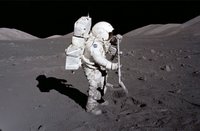NASA is forging ahead with plans to make water, oxygen, and hydrogen on the surface of the Moon and Mars. If we ever want to colonize other planets, it is vital that we find a way of extracting these vital gases and liquids from moons and planets, rather than transporting them from Earth (which is prohibitively expensive, due to Earth’s gravity). The current plan is to land a rover on the Moon in 2018 that will try to extract hydrogen, water, and oxygen — and then hopefully, Curiosity’s successor will try to convert the carbon dioxide in the atmosphere into oxygen in 2020 when it lands on Mars.
In 2018, NASA hopes to put a rover on the Moon that will carry the RESOLVE (Regolith and Environment Science and Oxygen & Lunar Volatile Extraction) science payload. RESOLVE will contain the various tools necessary to carry out in-situ resource utilization (ISRU). Basically, RESOLVE will sift through the Moon’s regolith (loose surface soil) and heat them up, looking for traces of hydrogen and oxygen, which can then be combined to make water. There is also some evidence that there’s water ice on the surface of the Moon — RESOLVE will find out for certain by heating the soil and seeing of water vapor emerges.
A similar payload would be attached to Curiosity’s successor, which is currently being specced out by NASA and will hopefully launch in 2020. This second IRSU experiment will probably suck in carbon dioxide from the Martian atmosphere, filter out the dust, and then process the CO2 into oxygen.
If either tech demonstration works as planned, future missions might include large-scale ISRU devices that are capable of producing significant amounts of hydrogen, oxygen, and water on the Moon or Mars. This would probably be the most important advance since we first landed on the Moon in the ’60s. Basically, as it stands, space travel needs lots of hydrogen and oxygen (rocket propellant) and water (to keep astronauts alive). Water has the unfortunate characteristic of being both heavy and incompressible, meaning it’s very difficult and expensive to lift large amounts of it into space (gravity can be really annoying sometimes). Likewise, unless we come up with some other way of powering our spacecraft, it’s infeasible to carry the rocket fuel that we’d need for exploration from Earth.
In short, if we want to colonize space, we really, really need some kind of base outside of the Earth’s atmosphere, preferably on the Moon — but Mars would be good, too
NASA is planning to make water and oxygen on the Moon and Mars by 2020
In 2018, NASA hopes to put a rover on the Moon that will carry the RESOLVE (Regolith and Environment Science and Oxygen & Lunar Volatile Extraction) science payload. RESOLVE will contain the various tools necessary to carry out in-situ resource utilization (ISRU). Basically, RESOLVE will sift through the Moon’s regolith (loose surface soil) and heat them up, looking for traces of hydrogen and oxygen, which can then be combined to make water. There is also some evidence that there’s water ice on the surface of the Moon — RESOLVE will find out for certain by heating the soil and seeing of water vapor emerges.
A similar payload would be attached to Curiosity’s successor, which is currently being specced out by NASA and will hopefully launch in 2020. This second IRSU experiment will probably suck in carbon dioxide from the Martian atmosphere, filter out the dust, and then process the CO2 into oxygen.
If either tech demonstration works as planned, future missions might include large-scale ISRU devices that are capable of producing significant amounts of hydrogen, oxygen, and water on the Moon or Mars. This would probably be the most important advance since we first landed on the Moon in the ’60s. Basically, as it stands, space travel needs lots of hydrogen and oxygen (rocket propellant) and water (to keep astronauts alive). Water has the unfortunate characteristic of being both heavy and incompressible, meaning it’s very difficult and expensive to lift large amounts of it into space (gravity can be really annoying sometimes). Likewise, unless we come up with some other way of powering our spacecraft, it’s infeasible to carry the rocket fuel that we’d need for exploration from Earth.
In short, if we want to colonize space, we really, really need some kind of base outside of the Earth’s atmosphere, preferably on the Moon — but Mars would be good, too
NASA is planning to make water and oxygen on the Moon and Mars by 2020


